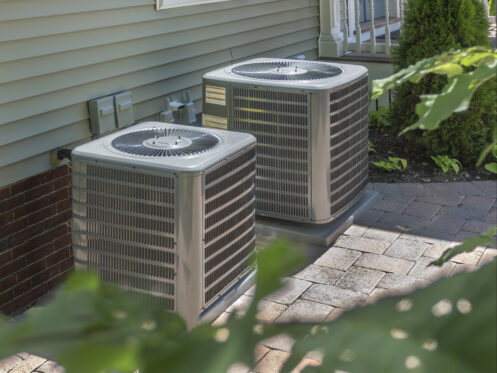Few homes in Dixon, CA still have standard thermostats with old-fashioned analog controls. Programmable thermostats that can manage multiple pre-set temperature changes are on their way out, too. Smart, Wi-Fi-enabled devices are the wave of the future.
Not only do smart thermostats have a far more expansive range of capabilities, but they’re also key fixtures in smart HVAC system designs. If you’re interested in optimizing the efficiency of your home’s climate control system, the following is everything you need to know about owning, installing, and using smart HVAC.
Zoning in Smart HVAC Systems
Installing a smart thermostat is only one small part of creating an energy-efficient smart HVAC system. Standard, central HVAC systems heat and cool entire homes uniformly. Most have a single central thermostat that governs all of their operations. With these systems, turning the air conditioner or heater on will alter the temperature in all building areas, even in those that are unoccupied.
HVAC zoning eliminates the energy waste that uniform heating and cooling often entails by dividing buildings into separate service areas. Each service area or zone receives its own thermostat, which is controlled independently of the others. With zoning, you can selectively heat or cool the spaces that people are actively using while routing conditioned air away from areas in which it isn’t wanted or needed.
Bypass Ducts and Duct Dampers
Most homes with central heating and cooling systems have adjustable air vents. When HVAC technicians provide air balancing services, they strategically adjust vent positions to ensure even airflow and uniform heating and cooling. Although some residents shut these vents entirely when they no longer want heated or cooled air, this isn’t their purpose.
Shutting one or more HVAC air vents and keeping them closed causes stress throughout your entire HVAC system. With nowhere to go, unwanted air creates a sudden and significant increase in static pressure within your ducting. This can lead to overheating, short cycling, and premature equipment failure.
To zone central HVAC systems, we install bypass ducts and duct dampers. Duct dampers open and close to either permit conditioned air or block it. Bypass ducts give unwanted air a place to go so that static pressure within HVAC ducting doesn’t rise too high.
Central Control Units
Central control units govern the movements of HVAC air duct dampers. These units receive signals from individual thermostats and respond accordingly. When heated or cooled air is needed in a specific area, central control units open the respective dampers to let it flow through. Control systems shut the related dampers and open bypass ducts when conditioned air is no longer needed. These seamlessly coordinated movements optimize HVAC efficiency without adding any stress to furnaces, air conditioners, or heat pumps.
Get Energy Consumption Reports and Other Helpful Data
With some smart thermostats, homeowners have ongoing access to valuable data on their energy consumption, HVAC system use, indoor air quality (IAQ), and more. With this info, consumers can make informed decisions concerning future efficiency upgrades or other home improvements to lower their energy bills.
These devices are also Wi-Fi-enabled. Homeowners can use the branded mobile apps that thermostat manufacturers supply to track temperature adjustments and settings, make temperature changes, and request energy reports from any location. As per Energy Star, smart thermostats can help homeowners reduce their HVAC-related energy use by as much as 8%.
Smart Thermostats Send Timely Reminders for HVAC Maintenance
Some smart thermostats also send timely reminders for air filter changes and annual AC and furnace tune-ups. When integrated with other smart home technologies, they simplify ongoing maintenance.
By constantly monitoring the integrity of HVAC systems using sensors, smart HVAC systems can even send alerts about small and developing problems. This way, homeowners can give important repairs the timely attention they deserve before HVAC issues spiral out of control.
Learning Capabilities
The smart thermostats that govern zoned HVAC systems are learning devices. Standard thermostats only allow for manual temperature adjustments, and programmable thermostats can simultaneously hold the commands for multiple pre-set temperature changes.
Comparatively, you can manually adjust a smart thermostat, pre-set a series of preferred temperatures, or let your thermostat manage ongoing temperature adjustments for you. By tracking and studying building residents’ movements, schedules, and preferences, these devices become increasingly skilled in adjusting themselves.
Geo-Fencing in Smart HVAC Systems
Imagine a home that constantly customizes its lighting, indoor climate, and comfort to suit your preferences, goals, and needs. Geo-fencing incorporates smart home technologies to streamline appliance, lighting, and device performance according to residents’ locations, activities, and more.
For instance, with geo-fencing, your smart thermostat will automatically turn your HVAC system on and set your preferred temperature before you arrive home from work. When you exit the building, it will lower or raise your thermostat setting to account for your absence.
According to the United States Department of Energy (DOE), making strategic temperature changes like these can help homeowners reduce their heating and cooling costs by as much as 10%. Smart HVAC systems optimize these savings by eliminating human error.
Integrated Home Systems and Features
Pairing a smart HVAC system with other intelligent home features can lead to additional energy savings. For instance, if you install smart blinds or other smart window treatments, they’ll automatically open and close to minimize or increase solar heat gains as needed. Your HVAC system will adjust its operations in accordance.
You can turn on your fireplace insert for ambiance, activate ceiling fans, or open your windows and doors for ventilation. Best of all, you can do so without manually adjusting your thermostat to reflect these changes.
Add Value to Your Home and Boost Its Marketability
Savvy home buyers are increasingly looking for smart home features. These improvements allow for smaller carbon footprints and more manageable overhead costs. Adding a smart HVAC system is a great way to update your home and keep it on par with current market standards. If you decide to sell your property, this addition will boost your listing’s marketability and allow you to command a higher asking price.
Finding the Right Smart HVAC Technologies for Assured Comfort
Although some people are diving headfirst into smart home appliances and features, capabilities like geo-fencing and activity tracking aren’t appealing to everyone. The good news is that you have the power to control just how smart your HVAC system is. You can turn specific features and functions off.
You can also choose equipment with a more limited and tightly controlled range of capabilities. As your comfort levels grow and you become more adept in leveraging these new technologies, you can add additional, compatible features or make strategic, single-feature updates.
We have a longstanding commitment to honesty, transparency, and integrity. Located in Dixon, CA, we proudly serve all of Solano and Yolo Counties. We offer outstanding central AC and furnace installation, maintenance, and repairs. We also provide heat pumps, ductless mini-splits, water heaters, and indoor air quality improvements. To find out about our preventative maintenance plans or schedule an appointment for smart HVAC installation, contact Greiner Heating, Air, and Electric now.

